
Wind turbine in Minnesota, U.S. Photo by: Tiffany Roufs.
Wind power is up to the challenge of providing more-than-enough energy for global society, according to two new and unrelated studies. Both studies, one published in Nature Climate Change and the other in the Proceedings of the National Academy of Sciences (PNAS), found that wind power from surface winds alone could produce hundreds of terrawatts (TW) meanwhile current global society uses around 18 TW.
“We’re not saying, ‘Put turbines everywhere,’ but we have shown that there is no fundamental barrier to obtaining half or even several times the world’s all-purpose power from wind by 2030. The potential is there, if we can build enough turbines,” said co-author of the PNAS study Mark Z. Jacobson, a civil and environmental engineer at Stanford.
Jacobson’s study Debunking concerns about the efficacy of wind power on a global scale, Jacobson employed complex computer modeling to find that while its true every additional wind turbine reduces the energy capacity of others, the reduction is not large enough to be a concern for global energy needs even when millions of wind turbines are operating worldwide simultaneously. Co-author Cristina Archer, with the College of Earth, Ocean, and Environment,
University of Delaware, called this discovery “very important.”
The other study in Nature Climate Change found that 400 TW of power could be produced by surface wind turbines alone. However, harnessing atmospheric winds could produce another 1,800 TW, around 100 times the amount currently used by global society. Atmospheric winds could be harnessed by kites with turbines built in.
“Looking at the big picture, it is more likely that economic, technological or political factors will determine the growth of wind power around the world, rather than geophysical limitations,” co-author Ken Caldeira, a climatologist with Carnegie, said. Powering the world with wind would produce some environmental impacts, but far less than fossil fuels. Calderia’s study found that powering the world solely with wind energy could reduce precipitation by 1 percent and raise temperatures by 0.1 degrees Celsius, but oil, coal, and gas.
However it’s clear from both of the studies that wind has the capacity to produce all the energy global society requires. Combined with other renewable energies, such as solar, geothermal, and tidal energy, wind could prove a major energy player in a post-fossil fuel world.
CITATION:
Kate Marvel, Ben Kravitz, and Ken Caldeira. Geophysical limits to global wind power. Nature Climate Change. DOI: 10.1038.
Mark Z. Jacobson and Cristina L. Archer. Saturation wind power potential and its implications for wind energy. Proceedings of the National Academy of Sciences (PNAS).
Related articles
Soccer lights up kids’ lives: new technology produces cheap, portable power

(07/16/2012) Recently, Jessica O. Matthews and Julia Silverman, both Harvard graduates, were awarded Harvard Foundation’s Scientists of the Year award for their invention of a soccer ball that converts kinetic energy to electricity. The two women, who were both social science majors, came up with the idea when they were taking an engineering class for non-majors and were required to create a project that would address a social problem.
Scientists: if we don’t act now we’re screwed

(06/07/2012) Scientists warn that the Earth may be reaching a planetary tipping point due to a unsustainable human pressures, while the UN releases a new report that finds global society has made significant progress on only four environmental issues out of ninety in the last twenty years. Climate change, overpopulation, overconsumption, and ecosystem destruction could lead to a tipping point that causes planetary collapse, according to a new paper in Nature by 22 scientists. The collapse may lead to a new planetary state that scientists say will be far harsher for human well-being, let alone survival.
Another record in global carbon emissions puts globe on track for ‘devastating consequences’

(05/29/2012) Last year global carbon dioxide emissions rose 3.2 percent to a new record of 31.6 gigatons, keeping the planet on track to suffer dangerous climate change, which could propel global crop failures, sea level rise, worsening extreme weather, and mass extinction. According to data from the International Energy Agency (IEA), China’s carbon emissions rose the most last year (9.3 percent) while emissions in Europe and the U.S. dipped slightly. China is the currently the world’s largest emitter of greenhouse gases, while the U.S. has emitted the most historically.
Mexico passes aggressive climate bill

(04/23/2012) Last week, Mexico’s Senate passed an aggressive and comprehensive climate change bill, making it the first developing nation and only the second country to do so, after the UK. The bill, which far outshines anything achieved by its far wealthier northern neighbors, sets ambitious targets for cutting emissions while creating new incentive programs for clean energy. Largely dependent on fossil fuels, Mexico is approximately the 11th highest greenhouse gas emitter in the world.
Activists worldwide push for leaving the fossil fuel age behind

(09/25/2011) On six continents, in over 75 percent of the world’s countries, people came out en masse yesterday to attend over 2,000 events to demonstrate the power of renewable energy to combat global climate change. As apart of the ‘Moving Planet’ campaign organized by 350.org, activists created a giant human-windmill in Paris, gave out bike lessons in Buenos Aires, practiced evacuation measure in the Pacific island of Tuvalu imperiled by rising sea levels, and marched in Cape Town for a strong agreement at the next UN climate meeting hosted in Durban, South Africa.
Germany proves the promise of renewable energy: hits 20 percent renewables
(09/06/2011) As many people in the United States question whether renewable energy is a viable alternative to fossil fuels, Germany now derives 20.8 percent of its electricity from renewable sources—a 15 percent increase since 2000, reports Der Spiegel. In contrast, the United States generates only 10 percent of its electricity from renewable sources, 6 percent of which comes from hydroelectric power, which some environmentalists see as unacceptably damaging.
Clean energy investments rise 630% in 7 years
(03/29/2011) According to a report by the US Pew Environment Group global clean energy investments, which do not include nuclear power, jumped 630% since 2004. The report detailing 2010 clean energy investments found that China remains the global leader in clean energy, while the US fell from 2nd to 3rd. This is the second year in a row that the US fell: in 2009 it lost first place to China. In all $243 billion were invested in clean energy in 2010.